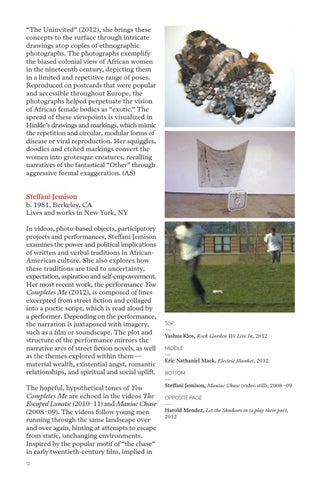“The Uninvited” (2012), she brings these concepts to the surface through intricate drawings atop copies of ethnographic photographs. The photographs exemplify the biased colonial view of African women in the nineteenth century, depicting them in a limited and repetitive range of poses. Reproduced on postcards that were popular and accessible throughout Europe, the photographs helped perpetuate the vision of African female bodies as “exotic.” The spread of these viewpoints is visualized in Hinkle’s drawings and markings, which mimic the repetition and circular, modular forms of disease or viral reproduction. Her squiggles, doodles and etched markings convert the women into grotesque creatures, recalling narratives of the fantastical “Other” through aggressive formal exaggeration. (AS)
blackness, masculinity and family structures within an urban prism. (JJ) Eric Nathaniel Mack b. 1987, Columbia, MD Lives and works in New York, NY Eric Nathaniel Mack alters articles of clothing, scraps of found cloth and pieces of utilitarian textiles in his work. By re-presenting these textiles, Mack references the work of artists such as Sam Gilliam, Robert Rauschenberg and David Hammons, who have challenged painting’s limitations and conventions with their material experimentations.
Steffani Jemison b. 1981, Berkeley, CA Lives and works in New York, NY In videos, photo-based objects, participatory projects and performances, Steffani Jemison examines the power and political implications of written and verbal traditions in AfricanAmerican culture. She also explores how these traditions are tied to uncertainty, expectation, aspiration and self-empowerment. Her most recent work, the performance You Completes Me (2012), is composed of lines excerpted from street fiction and collaged into a poetic script, which is read aloud by a performer. Depending on the performance, the narration is juxtaposed with imagery, such as a film or soundscape. The plot and structure of the performance mirrors the narrative arcs of street fiction novels, as well as the themes explored within them— material wealth, existential angst, romantic relationships, and spiritual and social uplift. The hopeful, hypothetical tones of You Completes Me are echoed in the videos The Escaped Lunatic (2010−11) and Maniac Chase (2008−09). The videos follow young men running through the same landscape over and over again, hinting at attempts to escape from static, unchanging environments. Inspired by the popular motif of “the chase” in early twentieth-century film, implied in 12
67611SMH.indd 12-13
her videos’ titles, Jemison draws a parallel to current events footage. (AS) Yashua Klos b. 1977, Chicago, IL Lives and works in New York, NY
top — Yashua Klos, Rock Garden We Live In, 2012 middle — Eric Nathaniel Mack, Electric Blanket, 2012 bottom — Steffani Jemison, Maniac Chase (video still), 2008–09 opposite page — Harold Mendez, Let the Shadows in to play their part, 2012
Yashua Klos’s large-scale collaged woodblock and relief prints are at once figurative and abstract. For example, Rock Garden We Live In (2012) shows an upward-gazing face emerging from a pile of rubble. In Black Hand Holding Unidentified Geometric Object (2010), a collection of bricks, rocks and wood form the shape of a hand. A head emerges from a rock formation in Naturally Occurring Floating Stalagmite 1 (2009), differentiated from surrounding textures only by a shock of facial hair at its edge. Klos engages ideas of transcendence and escape from social and economic realities, themes often explored in black cultural production, from scholar W.E.B. Du Bois to Afrofuturism. Composites of identity and environment, Klos’s work are steeped in memory and biography, laden with references to cosmology and otherworldly realities. Klos’s printed reproductions of detritus, collaged with faces, disembodied limbs and eyes speak to the constant fracturing and reconciliation of
In Honey hollow (2012) Mack uses the holes in pegboard as a stencil to apply paint onto a moving blanket, which is installed next to a fan. Adhering grommets and buttons, he replicates the circular shape of the paint and the material reference to apparel on the blanket. The blanket moves in response to the box fan’s whirl, imitating the idea of “gesture” associated with abstract painting while also adding a kinetic dimension to the work. (JJ) Harold Mendez b. 1977, Chicago, IL Lives and works in Chicago, IL Harold Mendez’s Let the Shadows in to play their part and We were alike and worse than mirrors of each other (both 2012) are comprised of dryer sheets, saturated with black spray paint, ink, dyes and graphite, arranged in a grid on paper. In cascading gradations of black and gray, both works are examples of Mendez’s ongoing interest in and experimentation with ordinary materials. Gathering used objects found in Chicago laundromats, the artist alludes to symbols of hygiene and waste. Likewise, his choice of titles evokes mystery and the embodiment of simultaneous presence and absence. The artist’s works on paper investigate a wide range of complex philosophical questions of being and existence through a deceptively simple visual language. Using dark and discarded matter, he gives new form to monochrome, used by many abstract pain13
11/7/12 10:12 AM
